LSBM102: Leadership and Management Report on Theories and Practices
VerifiedAdded on 2023/01/11
|14
|4557
|62
Report
AI Summary
This report delves into the core concepts of leadership and management, presenting a comprehensive literature review of key theories and practices. It explores the distinctions and similarities between leadership and management, highlighting their impact on organizational performance and productivity. The report examines behavioral theories, focusing on how leaders are shaped through experience, observation, and learning. It also analyzes trait theories, which emphasize the inherent qualities and characteristics of effective leaders. Furthermore, the report discusses the importance of leadership training and development programs, illustrating their benefits for both individuals and organizations, and touches upon the leadership program used by the National Health Service in the UK. The report aims to provide a well-rounded understanding of leadership and management, offering valuable insights for students and professionals alike.
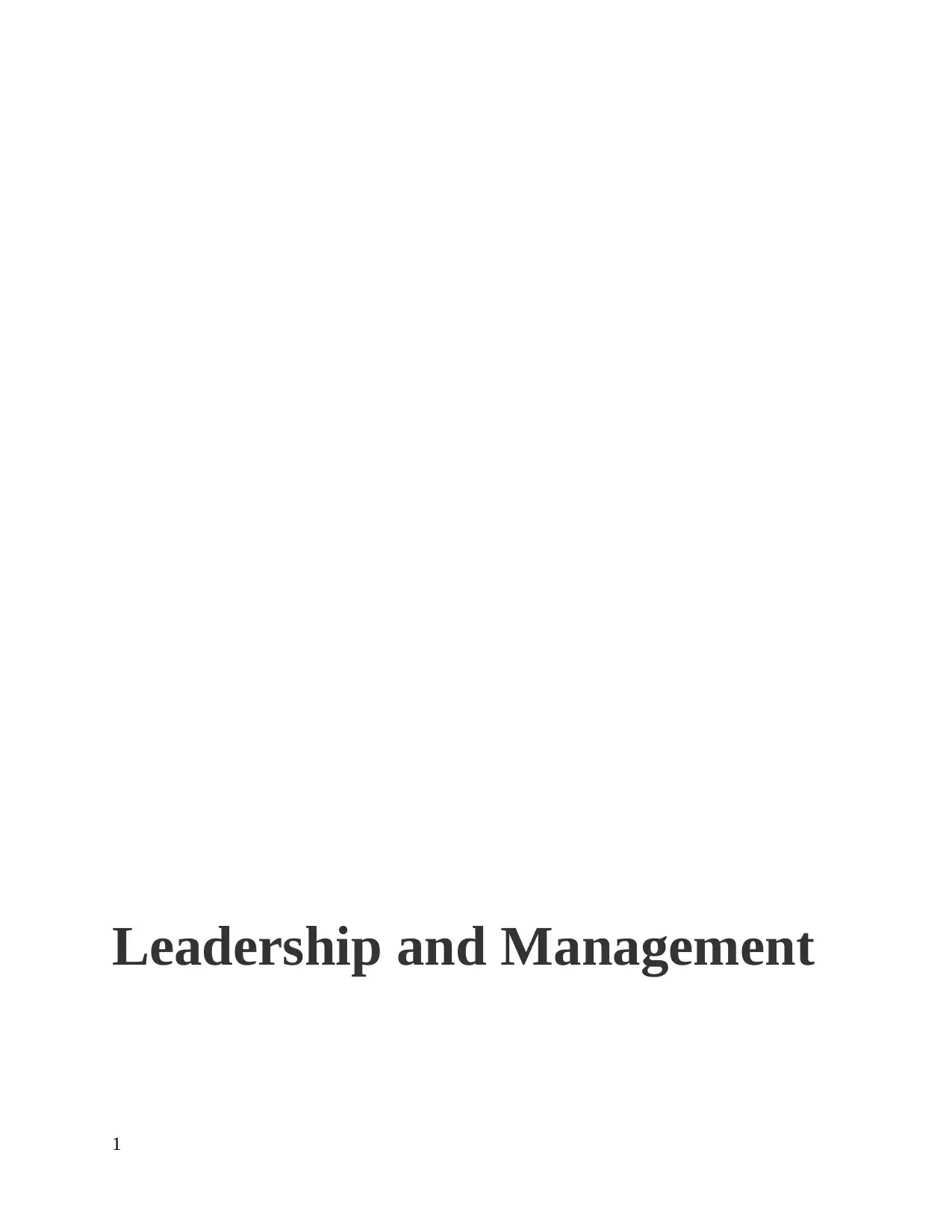
Leadership and Management
1
1
Paraphrase This Document
Need a fresh take? Get an instant paraphrase of this document with our AI Paraphraser
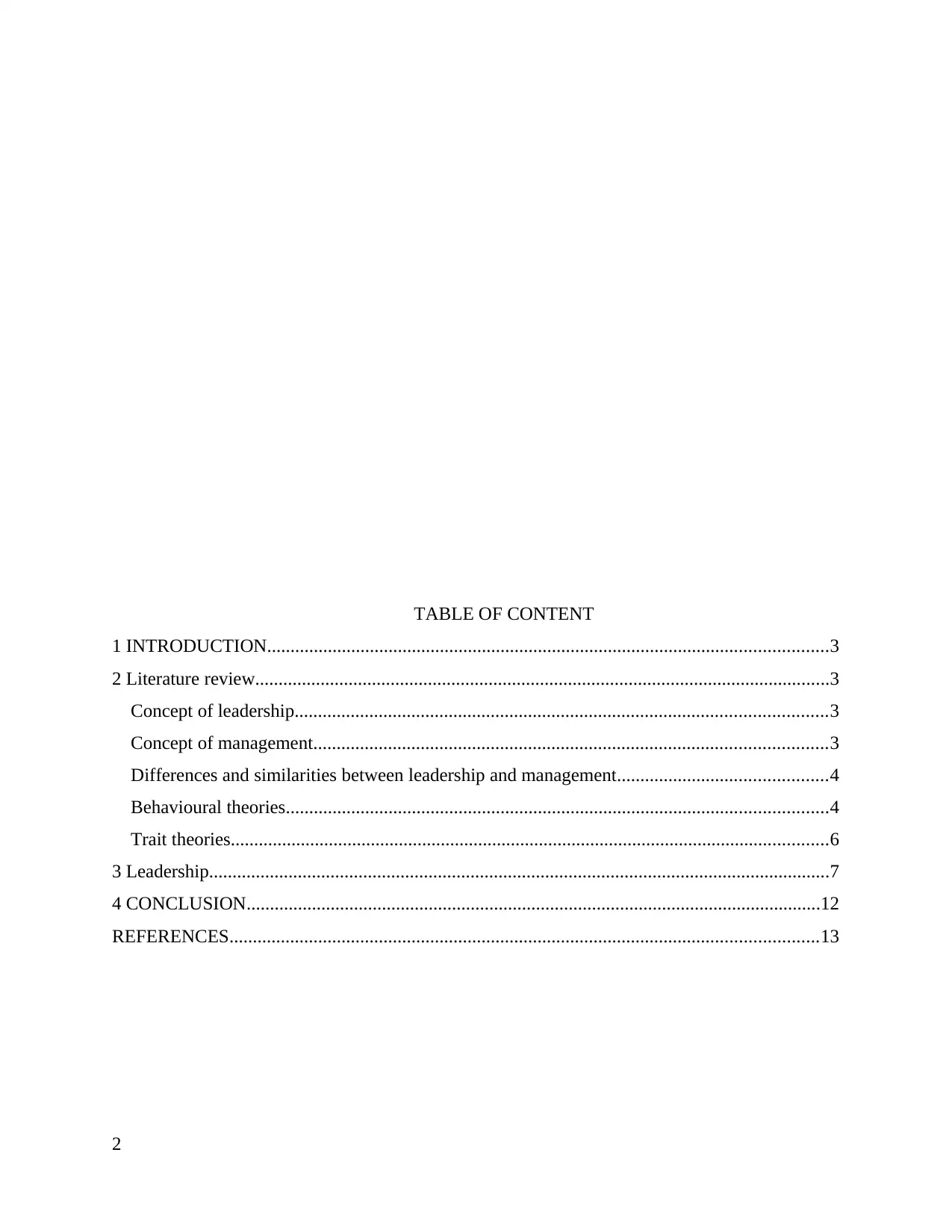
TABLE OF CONTENT
1 INTRODUCTION........................................................................................................................3
2 Literature review...........................................................................................................................3
Concept of leadership..................................................................................................................3
Concept of management..............................................................................................................3
Differences and similarities between leadership and management.............................................4
Behavioural theories....................................................................................................................4
Trait theories................................................................................................................................6
3 Leadership.....................................................................................................................................7
4 CONCLUSION...........................................................................................................................12
REFERENCES..............................................................................................................................13
2
1 INTRODUCTION........................................................................................................................3
2 Literature review...........................................................................................................................3
Concept of leadership..................................................................................................................3
Concept of management..............................................................................................................3
Differences and similarities between leadership and management.............................................4
Behavioural theories....................................................................................................................4
Trait theories................................................................................................................................6
3 Leadership.....................................................................................................................................7
4 CONCLUSION...........................................................................................................................12
REFERENCES..............................................................................................................................13
2
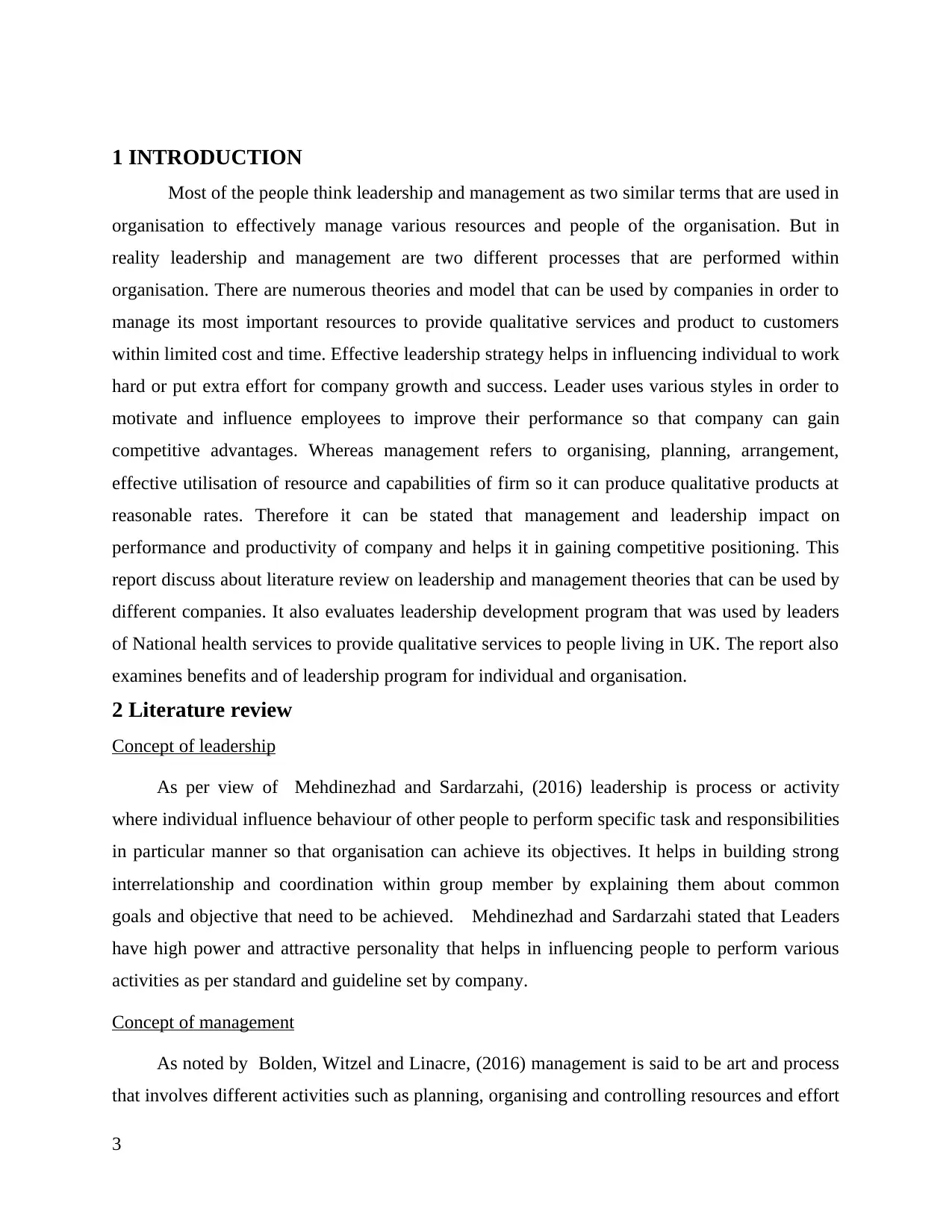
1 INTRODUCTION
Most of the people think leadership and management as two similar terms that are used in
organisation to effectively manage various resources and people of the organisation. But in
reality leadership and management are two different processes that are performed within
organisation. There are numerous theories and model that can be used by companies in order to
manage its most important resources to provide qualitative services and product to customers
within limited cost and time. Effective leadership strategy helps in influencing individual to work
hard or put extra effort for company growth and success. Leader uses various styles in order to
motivate and influence employees to improve their performance so that company can gain
competitive advantages. Whereas management refers to organising, planning, arrangement,
effective utilisation of resource and capabilities of firm so it can produce qualitative products at
reasonable rates. Therefore it can be stated that management and leadership impact on
performance and productivity of company and helps it in gaining competitive positioning. This
report discuss about literature review on leadership and management theories that can be used by
different companies. It also evaluates leadership development program that was used by leaders
of National health services to provide qualitative services to people living in UK. The report also
examines benefits and of leadership program for individual and organisation.
2 Literature review
Concept of leadership
As per view of Mehdinezhad and Sardarzahi, (2016) leadership is process or activity
where individual influence behaviour of other people to perform specific task and responsibilities
in particular manner so that organisation can achieve its objectives. It helps in building strong
interrelationship and coordination within group member by explaining them about common
goals and objective that need to be achieved. Mehdinezhad and Sardarzahi stated that Leaders
have high power and attractive personality that helps in influencing people to perform various
activities as per standard and guideline set by company.
Concept of management
As noted by Bolden, Witzel and Linacre, (2016) management is said to be art and process
that involves different activities such as planning, organising and controlling resources and effort
3
Most of the people think leadership and management as two similar terms that are used in
organisation to effectively manage various resources and people of the organisation. But in
reality leadership and management are two different processes that are performed within
organisation. There are numerous theories and model that can be used by companies in order to
manage its most important resources to provide qualitative services and product to customers
within limited cost and time. Effective leadership strategy helps in influencing individual to work
hard or put extra effort for company growth and success. Leader uses various styles in order to
motivate and influence employees to improve their performance so that company can gain
competitive advantages. Whereas management refers to organising, planning, arrangement,
effective utilisation of resource and capabilities of firm so it can produce qualitative products at
reasonable rates. Therefore it can be stated that management and leadership impact on
performance and productivity of company and helps it in gaining competitive positioning. This
report discuss about literature review on leadership and management theories that can be used by
different companies. It also evaluates leadership development program that was used by leaders
of National health services to provide qualitative services to people living in UK. The report also
examines benefits and of leadership program for individual and organisation.
2 Literature review
Concept of leadership
As per view of Mehdinezhad and Sardarzahi, (2016) leadership is process or activity
where individual influence behaviour of other people to perform specific task and responsibilities
in particular manner so that organisation can achieve its objectives. It helps in building strong
interrelationship and coordination within group member by explaining them about common
goals and objective that need to be achieved. Mehdinezhad and Sardarzahi stated that Leaders
have high power and attractive personality that helps in influencing people to perform various
activities as per standard and guideline set by company.
Concept of management
As noted by Bolden, Witzel and Linacre, (2016) management is said to be art and process
that involves different activities such as planning, organising and controlling resources and effort
3
⊘ This is a preview!⊘
Do you want full access?
Subscribe today to unlock all pages.

Trusted by 1+ million students worldwide
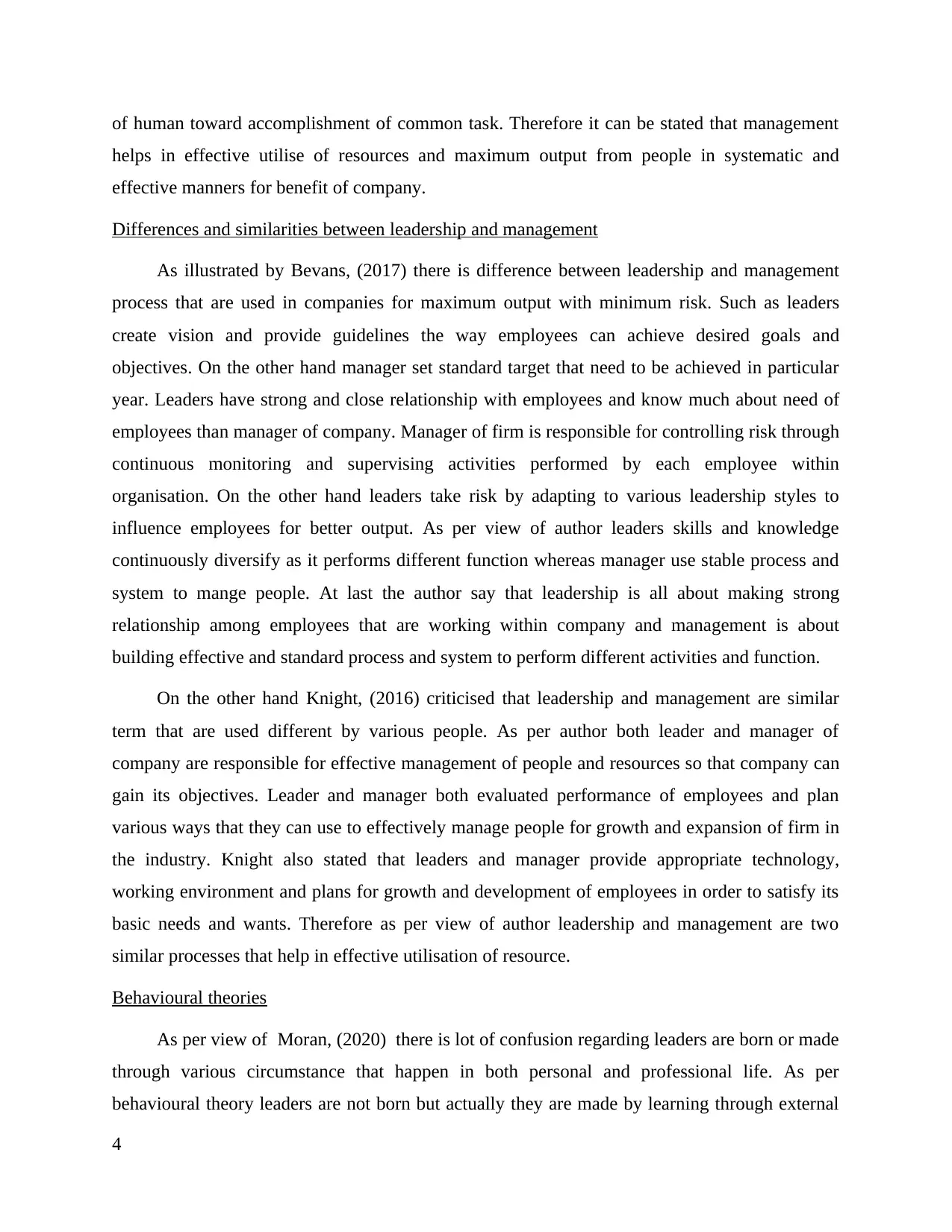
of human toward accomplishment of common task. Therefore it can be stated that management
helps in effective utilise of resources and maximum output from people in systematic and
effective manners for benefit of company.
Differences and similarities between leadership and management
As illustrated by Bevans, (2017) there is difference between leadership and management
process that are used in companies for maximum output with minimum risk. Such as leaders
create vision and provide guidelines the way employees can achieve desired goals and
objectives. On the other hand manager set standard target that need to be achieved in particular
year. Leaders have strong and close relationship with employees and know much about need of
employees than manager of company. Manager of firm is responsible for controlling risk through
continuous monitoring and supervising activities performed by each employee within
organisation. On the other hand leaders take risk by adapting to various leadership styles to
influence employees for better output. As per view of author leaders skills and knowledge
continuously diversify as it performs different function whereas manager use stable process and
system to mange people. At last the author say that leadership is all about making strong
relationship among employees that are working within company and management is about
building effective and standard process and system to perform different activities and function.
On the other hand Knight, (2016) criticised that leadership and management are similar
term that are used different by various people. As per author both leader and manager of
company are responsible for effective management of people and resources so that company can
gain its objectives. Leader and manager both evaluated performance of employees and plan
various ways that they can use to effectively manage people for growth and expansion of firm in
the industry. Knight also stated that leaders and manager provide appropriate technology,
working environment and plans for growth and development of employees in order to satisfy its
basic needs and wants. Therefore as per view of author leadership and management are two
similar processes that help in effective utilisation of resource.
Behavioural theories
As per view of Moran, (2020) there is lot of confusion regarding leaders are born or made
through various circumstance that happen in both personal and professional life. As per
behavioural theory leaders are not born but actually they are made by learning through external
4
helps in effective utilise of resources and maximum output from people in systematic and
effective manners for benefit of company.
Differences and similarities between leadership and management
As illustrated by Bevans, (2017) there is difference between leadership and management
process that are used in companies for maximum output with minimum risk. Such as leaders
create vision and provide guidelines the way employees can achieve desired goals and
objectives. On the other hand manager set standard target that need to be achieved in particular
year. Leaders have strong and close relationship with employees and know much about need of
employees than manager of company. Manager of firm is responsible for controlling risk through
continuous monitoring and supervising activities performed by each employee within
organisation. On the other hand leaders take risk by adapting to various leadership styles to
influence employees for better output. As per view of author leaders skills and knowledge
continuously diversify as it performs different function whereas manager use stable process and
system to mange people. At last the author say that leadership is all about making strong
relationship among employees that are working within company and management is about
building effective and standard process and system to perform different activities and function.
On the other hand Knight, (2016) criticised that leadership and management are similar
term that are used different by various people. As per author both leader and manager of
company are responsible for effective management of people and resources so that company can
gain its objectives. Leader and manager both evaluated performance of employees and plan
various ways that they can use to effectively manage people for growth and expansion of firm in
the industry. Knight also stated that leaders and manager provide appropriate technology,
working environment and plans for growth and development of employees in order to satisfy its
basic needs and wants. Therefore as per view of author leadership and management are two
similar processes that help in effective utilisation of resource.
Behavioural theories
As per view of Moran, (2020) there is lot of confusion regarding leaders are born or made
through various circumstance that happen in both personal and professional life. As per
behavioural theory leaders are not born but actually they are made by learning through external
4
Paraphrase This Document
Need a fresh take? Get an instant paraphrase of this document with our AI Paraphraser
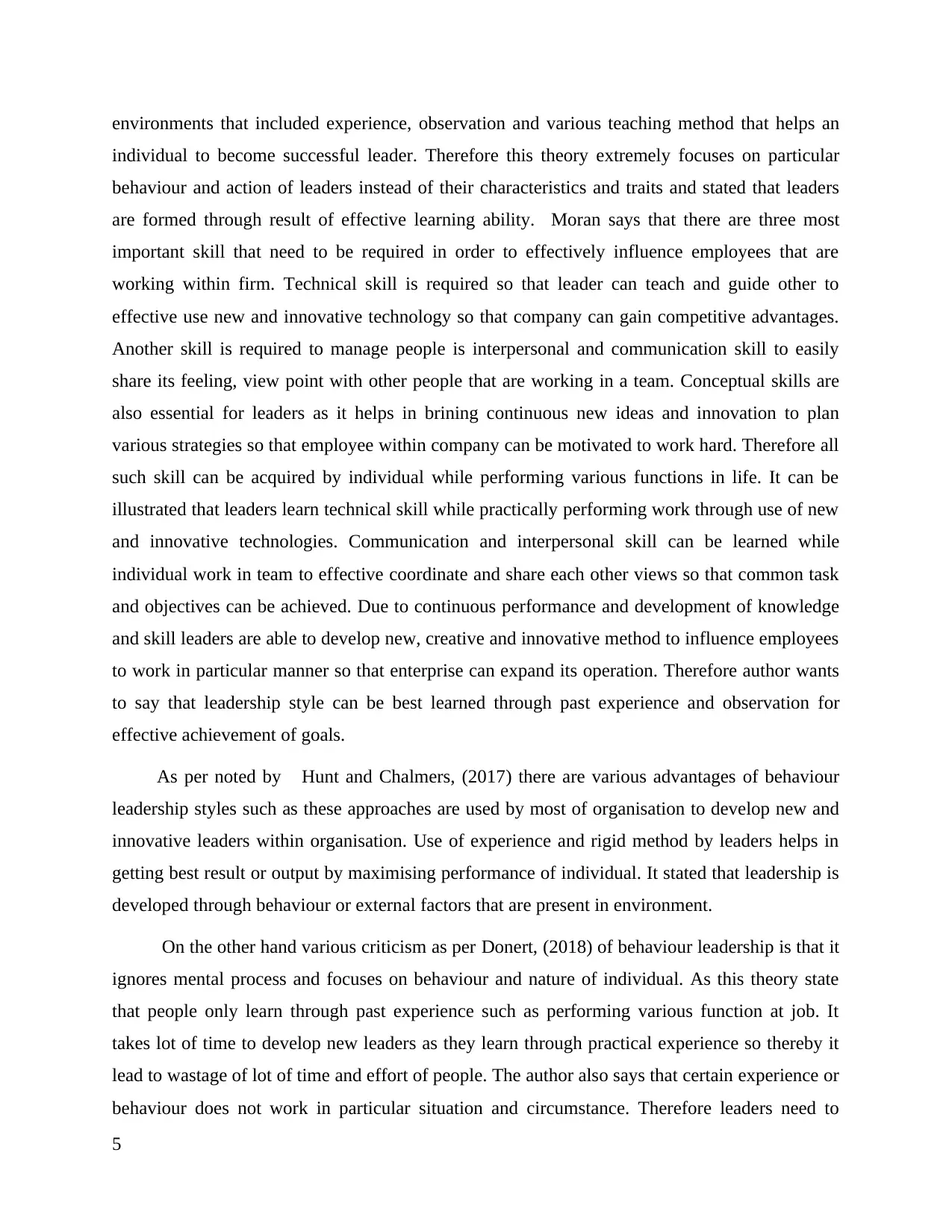
environments that included experience, observation and various teaching method that helps an
individual to become successful leader. Therefore this theory extremely focuses on particular
behaviour and action of leaders instead of their characteristics and traits and stated that leaders
are formed through result of effective learning ability. Moran says that there are three most
important skill that need to be required in order to effectively influence employees that are
working within firm. Technical skill is required so that leader can teach and guide other to
effective use new and innovative technology so that company can gain competitive advantages.
Another skill is required to manage people is interpersonal and communication skill to easily
share its feeling, view point with other people that are working in a team. Conceptual skills are
also essential for leaders as it helps in brining continuous new ideas and innovation to plan
various strategies so that employee within company can be motivated to work hard. Therefore all
such skill can be acquired by individual while performing various functions in life. It can be
illustrated that leaders learn technical skill while practically performing work through use of new
and innovative technologies. Communication and interpersonal skill can be learned while
individual work in team to effective coordinate and share each other views so that common task
and objectives can be achieved. Due to continuous performance and development of knowledge
and skill leaders are able to develop new, creative and innovative method to influence employees
to work in particular manner so that enterprise can expand its operation. Therefore author wants
to say that leadership style can be best learned through past experience and observation for
effective achievement of goals.
As per noted by Hunt and Chalmers, (2017) there are various advantages of behaviour
leadership styles such as these approaches are used by most of organisation to develop new and
innovative leaders within organisation. Use of experience and rigid method by leaders helps in
getting best result or output by maximising performance of individual. It stated that leadership is
developed through behaviour or external factors that are present in environment.
On the other hand various criticism as per Donert, (2018) of behaviour leadership is that it
ignores mental process and focuses on behaviour and nature of individual. As this theory state
that people only learn through past experience such as performing various function at job. It
takes lot of time to develop new leaders as they learn through practical experience so thereby it
lead to wastage of lot of time and effort of people. The author also says that certain experience or
behaviour does not work in particular situation and circumstance. Therefore leaders need to
5
individual to become successful leader. Therefore this theory extremely focuses on particular
behaviour and action of leaders instead of their characteristics and traits and stated that leaders
are formed through result of effective learning ability. Moran says that there are three most
important skill that need to be required in order to effectively influence employees that are
working within firm. Technical skill is required so that leader can teach and guide other to
effective use new and innovative technology so that company can gain competitive advantages.
Another skill is required to manage people is interpersonal and communication skill to easily
share its feeling, view point with other people that are working in a team. Conceptual skills are
also essential for leaders as it helps in brining continuous new ideas and innovation to plan
various strategies so that employee within company can be motivated to work hard. Therefore all
such skill can be acquired by individual while performing various functions in life. It can be
illustrated that leaders learn technical skill while practically performing work through use of new
and innovative technologies. Communication and interpersonal skill can be learned while
individual work in team to effective coordinate and share each other views so that common task
and objectives can be achieved. Due to continuous performance and development of knowledge
and skill leaders are able to develop new, creative and innovative method to influence employees
to work in particular manner so that enterprise can expand its operation. Therefore author wants
to say that leadership style can be best learned through past experience and observation for
effective achievement of goals.
As per noted by Hunt and Chalmers, (2017) there are various advantages of behaviour
leadership styles such as these approaches are used by most of organisation to develop new and
innovative leaders within organisation. Use of experience and rigid method by leaders helps in
getting best result or output by maximising performance of individual. It stated that leadership is
developed through behaviour or external factors that are present in environment.
On the other hand various criticism as per Donert, (2018) of behaviour leadership is that it
ignores mental process and focuses on behaviour and nature of individual. As this theory state
that people only learn through past experience such as performing various function at job. It
takes lot of time to develop new leaders as they learn through practical experience so thereby it
lead to wastage of lot of time and effort of people. The author also says that certain experience or
behaviour does not work in particular situation and circumstance. Therefore leaders need to
5
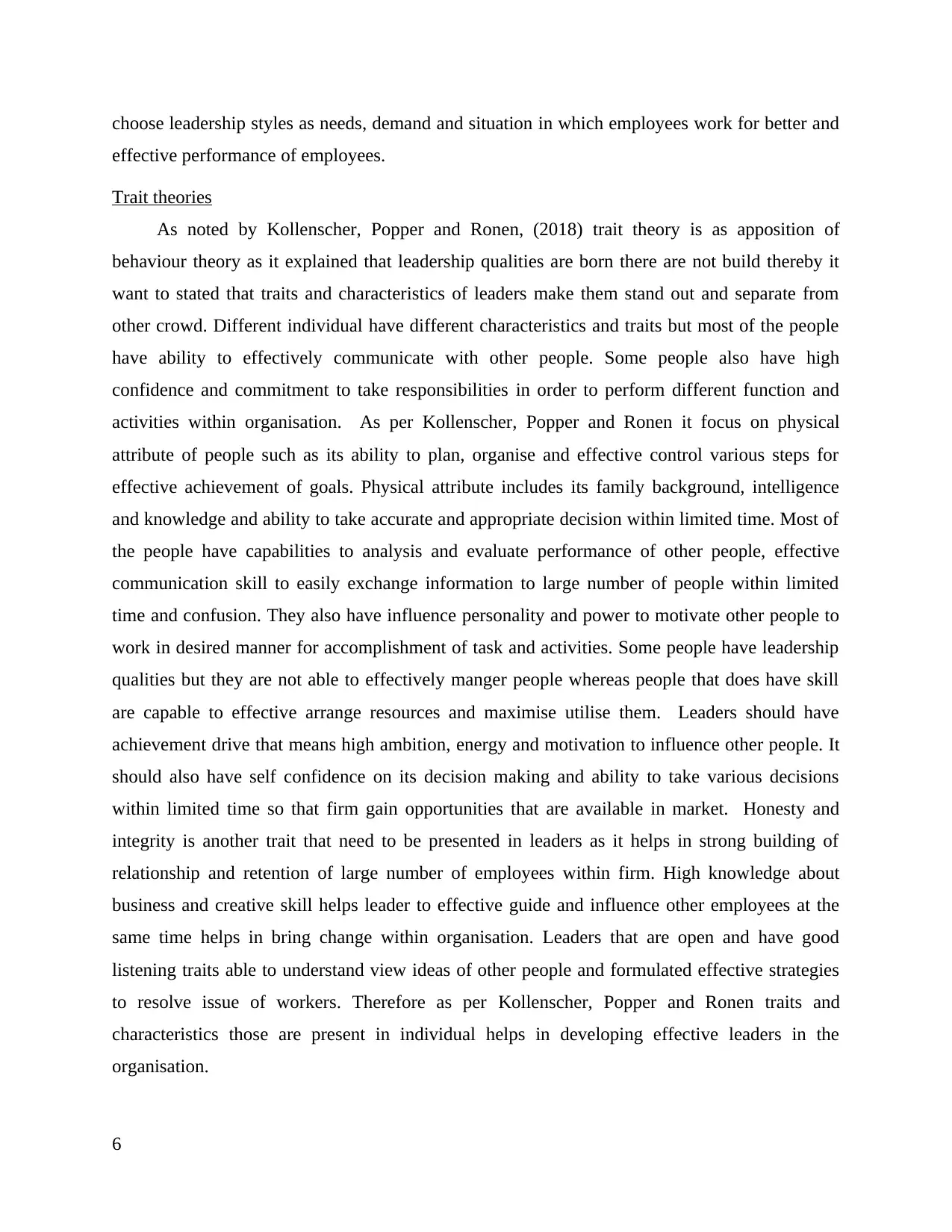
choose leadership styles as needs, demand and situation in which employees work for better and
effective performance of employees.
Trait theories
As noted by Kollenscher, Popper and Ronen, (2018) trait theory is as apposition of
behaviour theory as it explained that leadership qualities are born there are not build thereby it
want to stated that traits and characteristics of leaders make them stand out and separate from
other crowd. Different individual have different characteristics and traits but most of the people
have ability to effectively communicate with other people. Some people also have high
confidence and commitment to take responsibilities in order to perform different function and
activities within organisation. As per Kollenscher, Popper and Ronen it focus on physical
attribute of people such as its ability to plan, organise and effective control various steps for
effective achievement of goals. Physical attribute includes its family background, intelligence
and knowledge and ability to take accurate and appropriate decision within limited time. Most of
the people have capabilities to analysis and evaluate performance of other people, effective
communication skill to easily exchange information to large number of people within limited
time and confusion. They also have influence personality and power to motivate other people to
work in desired manner for accomplishment of task and activities. Some people have leadership
qualities but they are not able to effectively manger people whereas people that does have skill
are capable to effective arrange resources and maximise utilise them. Leaders should have
achievement drive that means high ambition, energy and motivation to influence other people. It
should also have self confidence on its decision making and ability to take various decisions
within limited time so that firm gain opportunities that are available in market. Honesty and
integrity is another trait that need to be presented in leaders as it helps in strong building of
relationship and retention of large number of employees within firm. High knowledge about
business and creative skill helps leader to effective guide and influence other employees at the
same time helps in bring change within organisation. Leaders that are open and have good
listening traits able to understand view ideas of other people and formulated effective strategies
to resolve issue of workers. Therefore as per Kollenscher, Popper and Ronen traits and
characteristics those are present in individual helps in developing effective leaders in the
organisation.
6
effective performance of employees.
Trait theories
As noted by Kollenscher, Popper and Ronen, (2018) trait theory is as apposition of
behaviour theory as it explained that leadership qualities are born there are not build thereby it
want to stated that traits and characteristics of leaders make them stand out and separate from
other crowd. Different individual have different characteristics and traits but most of the people
have ability to effectively communicate with other people. Some people also have high
confidence and commitment to take responsibilities in order to perform different function and
activities within organisation. As per Kollenscher, Popper and Ronen it focus on physical
attribute of people such as its ability to plan, organise and effective control various steps for
effective achievement of goals. Physical attribute includes its family background, intelligence
and knowledge and ability to take accurate and appropriate decision within limited time. Most of
the people have capabilities to analysis and evaluate performance of other people, effective
communication skill to easily exchange information to large number of people within limited
time and confusion. They also have influence personality and power to motivate other people to
work in desired manner for accomplishment of task and activities. Some people have leadership
qualities but they are not able to effectively manger people whereas people that does have skill
are capable to effective arrange resources and maximise utilise them. Leaders should have
achievement drive that means high ambition, energy and motivation to influence other people. It
should also have self confidence on its decision making and ability to take various decisions
within limited time so that firm gain opportunities that are available in market. Honesty and
integrity is another trait that need to be presented in leaders as it helps in strong building of
relationship and retention of large number of employees within firm. High knowledge about
business and creative skill helps leader to effective guide and influence other employees at the
same time helps in bring change within organisation. Leaders that are open and have good
listening traits able to understand view ideas of other people and formulated effective strategies
to resolve issue of workers. Therefore as per Kollenscher, Popper and Ronen traits and
characteristics those are present in individual helps in developing effective leaders in the
organisation.
6
⊘ This is a preview!⊘
Do you want full access?
Subscribe today to unlock all pages.

Trusted by 1+ million students worldwide
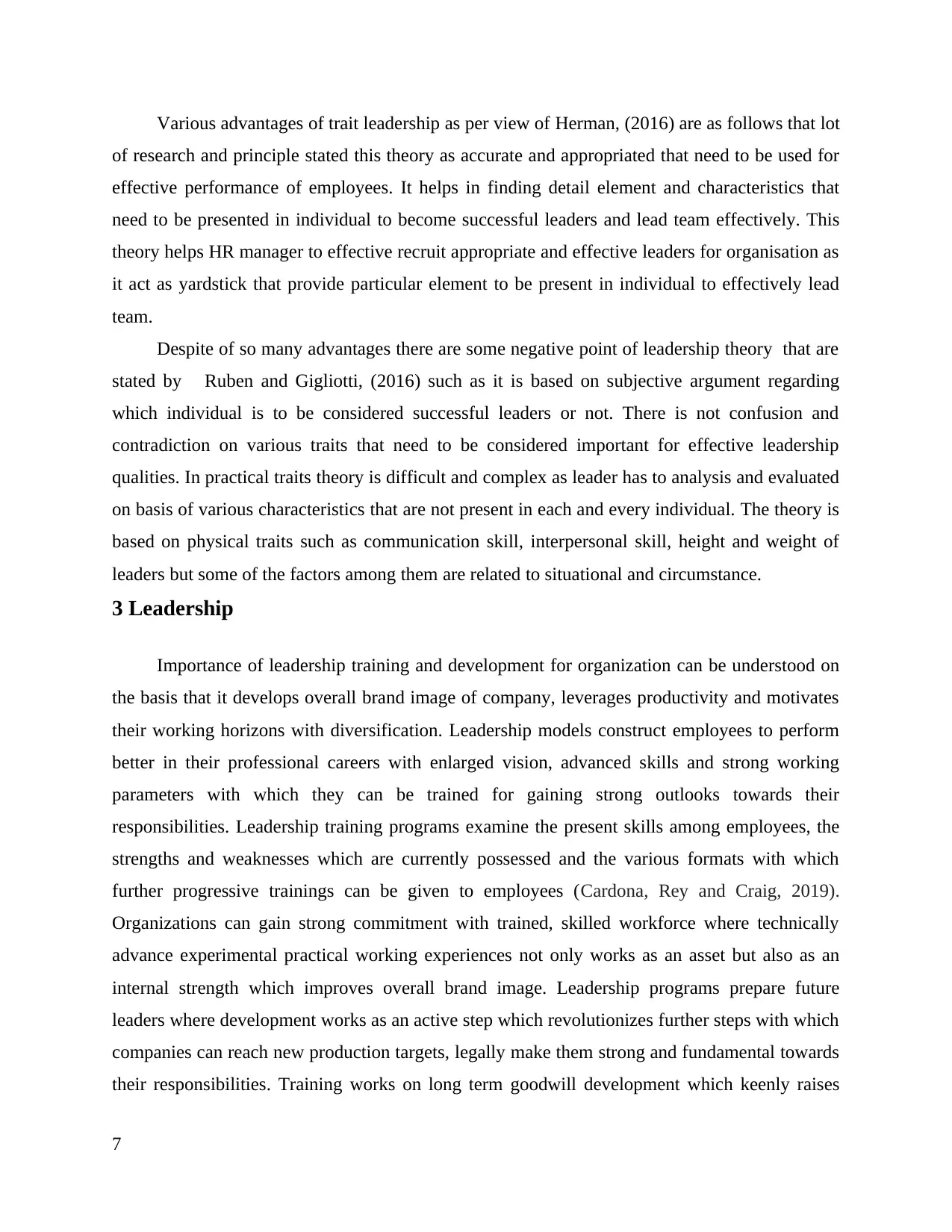
Various advantages of trait leadership as per view of Herman, (2016) are as follows that lot
of research and principle stated this theory as accurate and appropriated that need to be used for
effective performance of employees. It helps in finding detail element and characteristics that
need to be presented in individual to become successful leaders and lead team effectively. This
theory helps HR manager to effective recruit appropriate and effective leaders for organisation as
it act as yardstick that provide particular element to be present in individual to effectively lead
team.
Despite of so many advantages there are some negative point of leadership theory that are
stated by Ruben and Gigliotti, (2016) such as it is based on subjective argument regarding
which individual is to be considered successful leaders or not. There is not confusion and
contradiction on various traits that need to be considered important for effective leadership
qualities. In practical traits theory is difficult and complex as leader has to analysis and evaluated
on basis of various characteristics that are not present in each and every individual. The theory is
based on physical traits such as communication skill, interpersonal skill, height and weight of
leaders but some of the factors among them are related to situational and circumstance.
3 Leadership
Importance of leadership training and development for organization can be understood on
the basis that it develops overall brand image of company, leverages productivity and motivates
their working horizons with diversification. Leadership models construct employees to perform
better in their professional careers with enlarged vision, advanced skills and strong working
parameters with which they can be trained for gaining strong outlooks towards their
responsibilities. Leadership training programs examine the present skills among employees, the
strengths and weaknesses which are currently possessed and the various formats with which
further progressive trainings can be given to employees (Cardona, Rey and Craig, 2019).
Organizations can gain strong commitment with trained, skilled workforce where technically
advance experimental practical working experiences not only works as an asset but also as an
internal strength which improves overall brand image. Leadership programs prepare future
leaders where development works as an active step which revolutionizes further steps with which
companies can reach new production targets, legally make them strong and fundamental towards
their responsibilities. Training works on long term goodwill development which keenly raises
7
of research and principle stated this theory as accurate and appropriated that need to be used for
effective performance of employees. It helps in finding detail element and characteristics that
need to be presented in individual to become successful leaders and lead team effectively. This
theory helps HR manager to effective recruit appropriate and effective leaders for organisation as
it act as yardstick that provide particular element to be present in individual to effectively lead
team.
Despite of so many advantages there are some negative point of leadership theory that are
stated by Ruben and Gigliotti, (2016) such as it is based on subjective argument regarding
which individual is to be considered successful leaders or not. There is not confusion and
contradiction on various traits that need to be considered important for effective leadership
qualities. In practical traits theory is difficult and complex as leader has to analysis and evaluated
on basis of various characteristics that are not present in each and every individual. The theory is
based on physical traits such as communication skill, interpersonal skill, height and weight of
leaders but some of the factors among them are related to situational and circumstance.
3 Leadership
Importance of leadership training and development for organization can be understood on
the basis that it develops overall brand image of company, leverages productivity and motivates
their working horizons with diversification. Leadership models construct employees to perform
better in their professional careers with enlarged vision, advanced skills and strong working
parameters with which they can be trained for gaining strong outlooks towards their
responsibilities. Leadership training programs examine the present skills among employees, the
strengths and weaknesses which are currently possessed and the various formats with which
further progressive trainings can be given to employees (Cardona, Rey and Craig, 2019).
Organizations can gain strong commitment with trained, skilled workforce where technically
advance experimental practical working experiences not only works as an asset but also as an
internal strength which improves overall brand image. Leadership programs prepare future
leaders where development works as an active step which revolutionizes further steps with which
companies can reach new production targets, legally make them strong and fundamental towards
their responsibilities. Training works on long term goodwill development which keenly raises
7
Paraphrase This Document
Need a fresh take? Get an instant paraphrase of this document with our AI Paraphraser
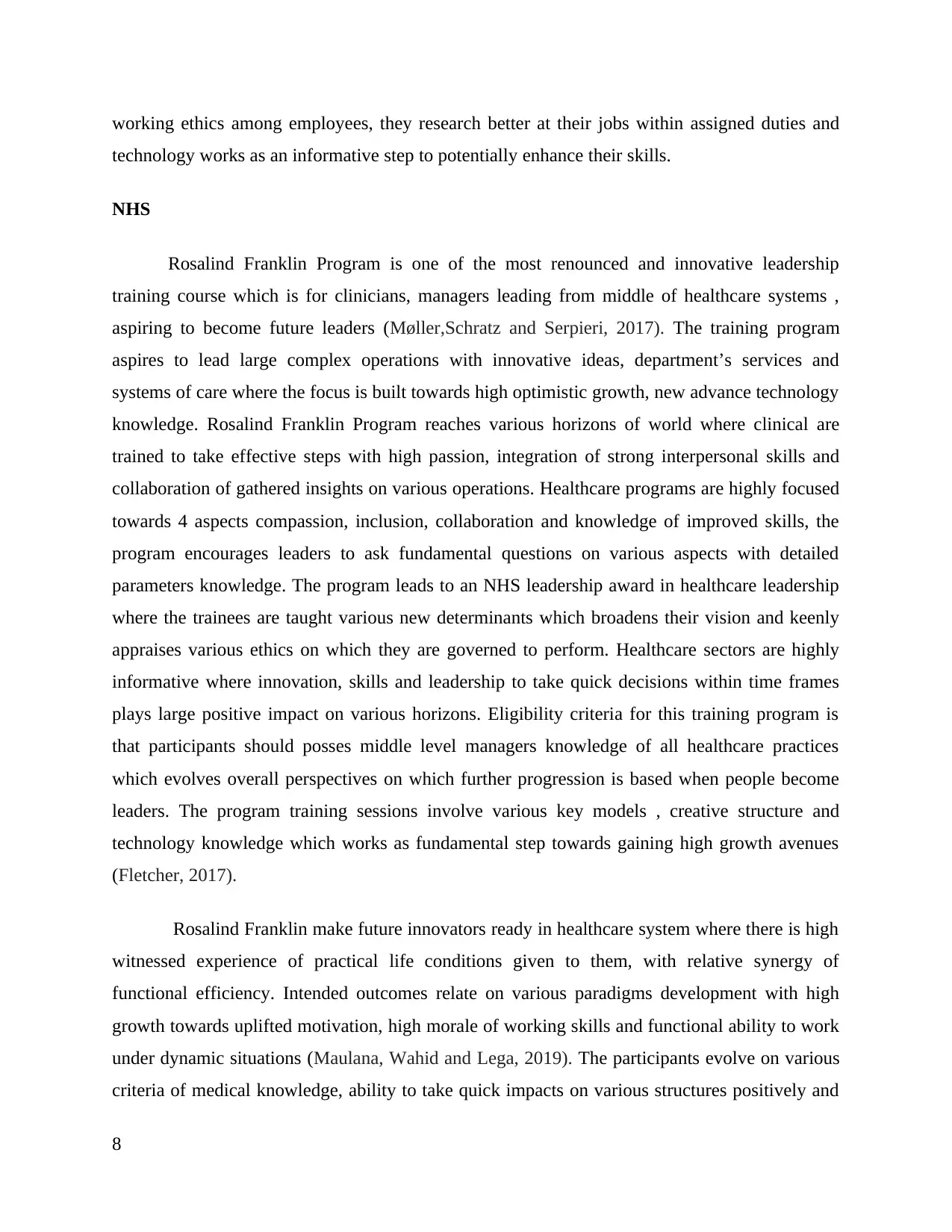
working ethics among employees, they research better at their jobs within assigned duties and
technology works as an informative step to potentially enhance their skills.
NHS
Rosalind Franklin Program is one of the most renounced and innovative leadership
training course which is for clinicians, managers leading from middle of healthcare systems ,
aspiring to become future leaders (Møller,Schratz and Serpieri, 2017). The training program
aspires to lead large complex operations with innovative ideas, department’s services and
systems of care where the focus is built towards high optimistic growth, new advance technology
knowledge. Rosalind Franklin Program reaches various horizons of world where clinical are
trained to take effective steps with high passion, integration of strong interpersonal skills and
collaboration of gathered insights on various operations. Healthcare programs are highly focused
towards 4 aspects compassion, inclusion, collaboration and knowledge of improved skills, the
program encourages leaders to ask fundamental questions on various aspects with detailed
parameters knowledge. The program leads to an NHS leadership award in healthcare leadership
where the trainees are taught various new determinants which broadens their vision and keenly
appraises various ethics on which they are governed to perform. Healthcare sectors are highly
informative where innovation, skills and leadership to take quick decisions within time frames
plays large positive impact on various horizons. Eligibility criteria for this training program is
that participants should posses middle level managers knowledge of all healthcare practices
which evolves overall perspectives on which further progression is based when people become
leaders. The program training sessions involve various key models , creative structure and
technology knowledge which works as fundamental step towards gaining high growth avenues
(Fletcher, 2017).
Rosalind Franklin make future innovators ready in healthcare system where there is high
witnessed experience of practical life conditions given to them, with relative synergy of
functional efficiency. Intended outcomes relate on various paradigms development with high
growth towards uplifted motivation, high morale of working skills and functional ability to work
under dynamic situations (Maulana, Wahid and Lega, 2019). The participants evolve on various
criteria of medical knowledge, ability to take quick impacts on various structures positively and
8
technology works as an informative step to potentially enhance their skills.
NHS
Rosalind Franklin Program is one of the most renounced and innovative leadership
training course which is for clinicians, managers leading from middle of healthcare systems ,
aspiring to become future leaders (Møller,Schratz and Serpieri, 2017). The training program
aspires to lead large complex operations with innovative ideas, department’s services and
systems of care where the focus is built towards high optimistic growth, new advance technology
knowledge. Rosalind Franklin Program reaches various horizons of world where clinical are
trained to take effective steps with high passion, integration of strong interpersonal skills and
collaboration of gathered insights on various operations. Healthcare programs are highly focused
towards 4 aspects compassion, inclusion, collaboration and knowledge of improved skills, the
program encourages leaders to ask fundamental questions on various aspects with detailed
parameters knowledge. The program leads to an NHS leadership award in healthcare leadership
where the trainees are taught various new determinants which broadens their vision and keenly
appraises various ethics on which they are governed to perform. Healthcare sectors are highly
informative where innovation, skills and leadership to take quick decisions within time frames
plays large positive impact on various horizons. Eligibility criteria for this training program is
that participants should posses middle level managers knowledge of all healthcare practices
which evolves overall perspectives on which further progression is based when people become
leaders. The program training sessions involve various key models , creative structure and
technology knowledge which works as fundamental step towards gaining high growth avenues
(Fletcher, 2017).
Rosalind Franklin make future innovators ready in healthcare system where there is high
witnessed experience of practical life conditions given to them, with relative synergy of
functional efficiency. Intended outcomes relate on various paradigms development with high
growth towards uplifted motivation, high morale of working skills and functional ability to work
under dynamic situations (Maulana, Wahid and Lega, 2019). The participants evolve on various
criteria of medical knowledge, ability to take quick impacts on various structures positively and
8
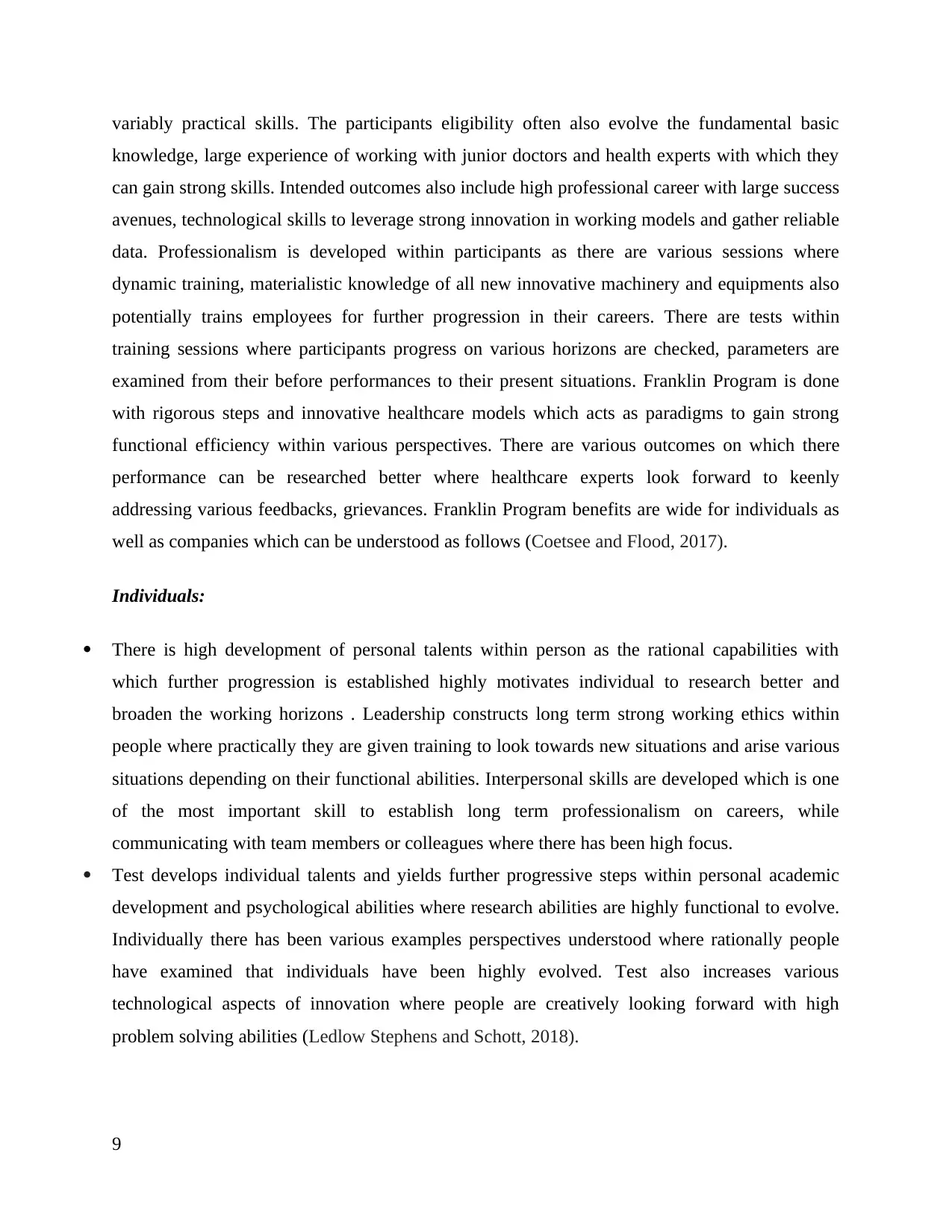
variably practical skills. The participants eligibility often also evolve the fundamental basic
knowledge, large experience of working with junior doctors and health experts with which they
can gain strong skills. Intended outcomes also include high professional career with large success
avenues, technological skills to leverage strong innovation in working models and gather reliable
data. Professionalism is developed within participants as there are various sessions where
dynamic training, materialistic knowledge of all new innovative machinery and equipments also
potentially trains employees for further progression in their careers. There are tests within
training sessions where participants progress on various horizons are checked, parameters are
examined from their before performances to their present situations. Franklin Program is done
with rigorous steps and innovative healthcare models which acts as paradigms to gain strong
functional efficiency within various perspectives. There are various outcomes on which there
performance can be researched better where healthcare experts look forward to keenly
addressing various feedbacks, grievances. Franklin Program benefits are wide for individuals as
well as companies which can be understood as follows (Coetsee and Flood, 2017).
Individuals:
There is high development of personal talents within person as the rational capabilities with
which further progression is established highly motivates individual to research better and
broaden the working horizons . Leadership constructs long term strong working ethics within
people where practically they are given training to look towards new situations and arise various
situations depending on their functional abilities. Interpersonal skills are developed which is one
of the most important skill to establish long term professionalism on careers, while
communicating with team members or colleagues where there has been high focus.
Test develops individual talents and yields further progressive steps within personal academic
development and psychological abilities where research abilities are highly functional to evolve.
Individually there has been various examples perspectives understood where rationally people
have examined that individuals have been highly evolved. Test also increases various
technological aspects of innovation where people are creatively looking forward with high
problem solving abilities (Ledlow Stephens and Schott, 2018).
9
knowledge, large experience of working with junior doctors and health experts with which they
can gain strong skills. Intended outcomes also include high professional career with large success
avenues, technological skills to leverage strong innovation in working models and gather reliable
data. Professionalism is developed within participants as there are various sessions where
dynamic training, materialistic knowledge of all new innovative machinery and equipments also
potentially trains employees for further progression in their careers. There are tests within
training sessions where participants progress on various horizons are checked, parameters are
examined from their before performances to their present situations. Franklin Program is done
with rigorous steps and innovative healthcare models which acts as paradigms to gain strong
functional efficiency within various perspectives. There are various outcomes on which there
performance can be researched better where healthcare experts look forward to keenly
addressing various feedbacks, grievances. Franklin Program benefits are wide for individuals as
well as companies which can be understood as follows (Coetsee and Flood, 2017).
Individuals:
There is high development of personal talents within person as the rational capabilities with
which further progression is established highly motivates individual to research better and
broaden the working horizons . Leadership constructs long term strong working ethics within
people where practically they are given training to look towards new situations and arise various
situations depending on their functional abilities. Interpersonal skills are developed which is one
of the most important skill to establish long term professionalism on careers, while
communicating with team members or colleagues where there has been high focus.
Test develops individual talents and yields further progressive steps within personal academic
development and psychological abilities where research abilities are highly functional to evolve.
Individually there has been various examples perspectives understood where rationally people
have examined that individuals have been highly evolved. Test also increases various
technological aspects of innovation where people are creatively looking forward with high
problem solving abilities (Ledlow Stephens and Schott, 2018).
9
⊘ This is a preview!⊘
Do you want full access?
Subscribe today to unlock all pages.

Trusted by 1+ million students worldwide
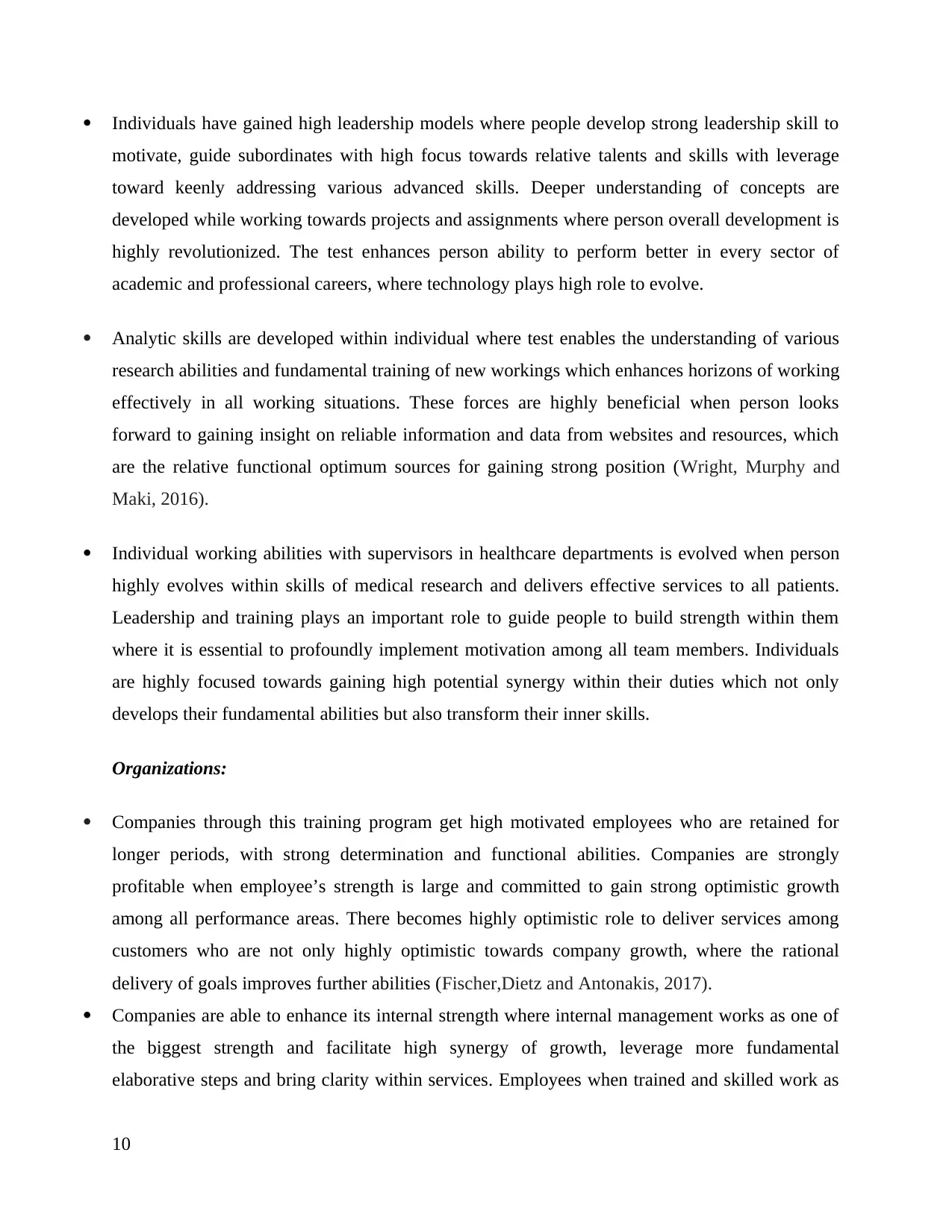
Individuals have gained high leadership models where people develop strong leadership skill to
motivate, guide subordinates with high focus towards relative talents and skills with leverage
toward keenly addressing various advanced skills. Deeper understanding of concepts are
developed while working towards projects and assignments where person overall development is
highly revolutionized. The test enhances person ability to perform better in every sector of
academic and professional careers, where technology plays high role to evolve.
Analytic skills are developed within individual where test enables the understanding of various
research abilities and fundamental training of new workings which enhances horizons of working
effectively in all working situations. These forces are highly beneficial when person looks
forward to gaining insight on reliable information and data from websites and resources, which
are the relative functional optimum sources for gaining strong position (Wright, Murphy and
Maki, 2016).
Individual working abilities with supervisors in healthcare departments is evolved when person
highly evolves within skills of medical research and delivers effective services to all patients.
Leadership and training plays an important role to guide people to build strength within them
where it is essential to profoundly implement motivation among all team members. Individuals
are highly focused towards gaining high potential synergy within their duties which not only
develops their fundamental abilities but also transform their inner skills.
Organizations:
Companies through this training program get high motivated employees who are retained for
longer periods, with strong determination and functional abilities. Companies are strongly
profitable when employee’s strength is large and committed to gain strong optimistic growth
among all performance areas. There becomes highly optimistic role to deliver services among
customers who are not only highly optimistic towards company growth, where the rational
delivery of goals improves further abilities (Fischer,Dietz and Antonakis, 2017).
Companies are able to enhance its internal strength where internal management works as one of
the biggest strength and facilitate high synergy of growth, leverage more fundamental
elaborative steps and bring clarity within services. Employees when trained and skilled work as
10
motivate, guide subordinates with high focus towards relative talents and skills with leverage
toward keenly addressing various advanced skills. Deeper understanding of concepts are
developed while working towards projects and assignments where person overall development is
highly revolutionized. The test enhances person ability to perform better in every sector of
academic and professional careers, where technology plays high role to evolve.
Analytic skills are developed within individual where test enables the understanding of various
research abilities and fundamental training of new workings which enhances horizons of working
effectively in all working situations. These forces are highly beneficial when person looks
forward to gaining insight on reliable information and data from websites and resources, which
are the relative functional optimum sources for gaining strong position (Wright, Murphy and
Maki, 2016).
Individual working abilities with supervisors in healthcare departments is evolved when person
highly evolves within skills of medical research and delivers effective services to all patients.
Leadership and training plays an important role to guide people to build strength within them
where it is essential to profoundly implement motivation among all team members. Individuals
are highly focused towards gaining high potential synergy within their duties which not only
develops their fundamental abilities but also transform their inner skills.
Organizations:
Companies through this training program get high motivated employees who are retained for
longer periods, with strong determination and functional abilities. Companies are strongly
profitable when employee’s strength is large and committed to gain strong optimistic growth
among all performance areas. There becomes highly optimistic role to deliver services among
customers who are not only highly optimistic towards company growth, where the rational
delivery of goals improves further abilities (Fischer,Dietz and Antonakis, 2017).
Companies are able to enhance its internal strength where internal management works as one of
the biggest strength and facilitate high synergy of growth, leverage more fundamental
elaborative steps and bring clarity within services. Employees when trained and skilled work as
10
Paraphrase This Document
Need a fresh take? Get an instant paraphrase of this document with our AI Paraphraser
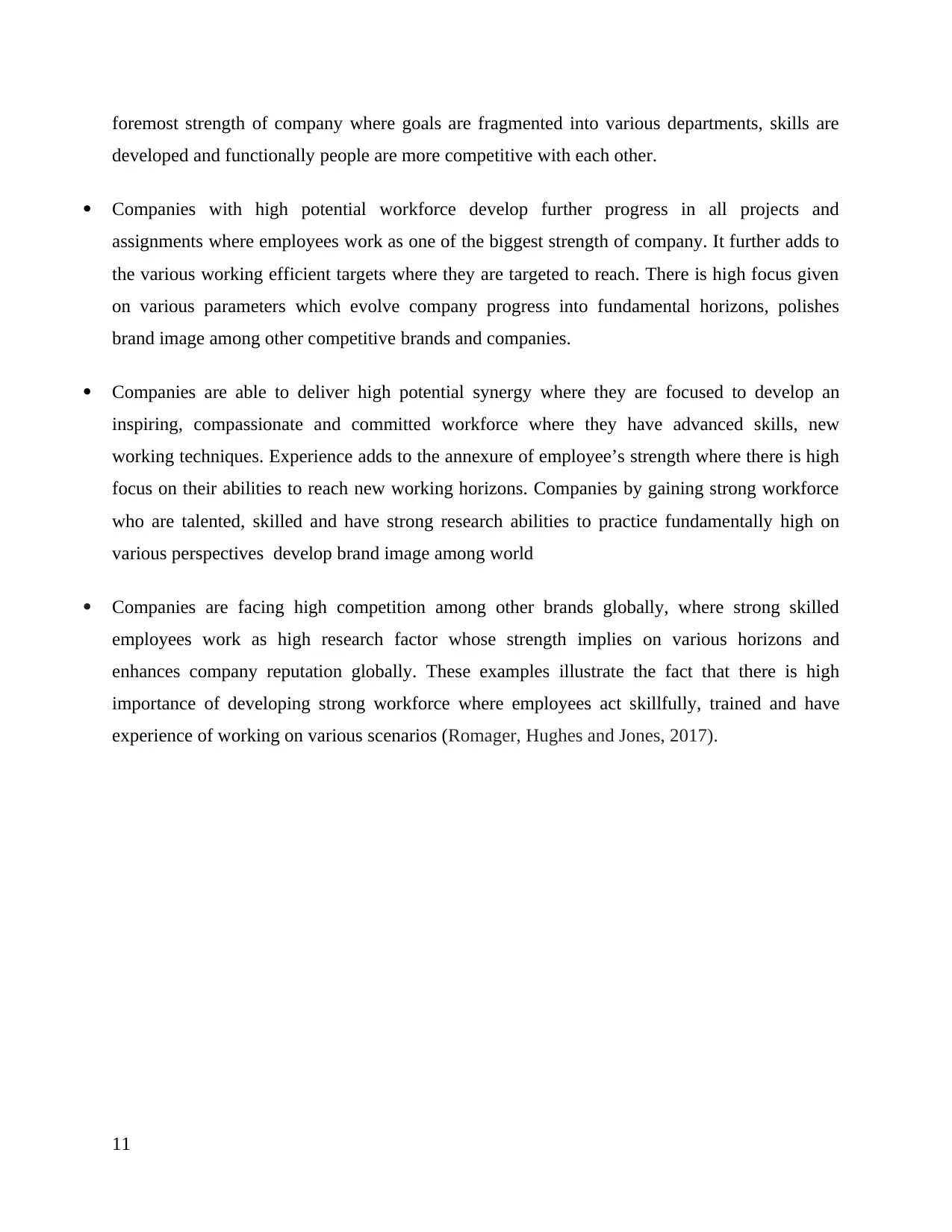
foremost strength of company where goals are fragmented into various departments, skills are
developed and functionally people are more competitive with each other.
Companies with high potential workforce develop further progress in all projects and
assignments where employees work as one of the biggest strength of company. It further adds to
the various working efficient targets where they are targeted to reach. There is high focus given
on various parameters which evolve company progress into fundamental horizons, polishes
brand image among other competitive brands and companies.
Companies are able to deliver high potential synergy where they are focused to develop an
inspiring, compassionate and committed workforce where they have advanced skills, new
working techniques. Experience adds to the annexure of employee’s strength where there is high
focus on their abilities to reach new working horizons. Companies by gaining strong workforce
who are talented, skilled and have strong research abilities to practice fundamentally high on
various perspectives develop brand image among world
Companies are facing high competition among other brands globally, where strong skilled
employees work as high research factor whose strength implies on various horizons and
enhances company reputation globally. These examples illustrate the fact that there is high
importance of developing strong workforce where employees act skillfully, trained and have
experience of working on various scenarios (Romager, Hughes and Jones, 2017).
11
developed and functionally people are more competitive with each other.
Companies with high potential workforce develop further progress in all projects and
assignments where employees work as one of the biggest strength of company. It further adds to
the various working efficient targets where they are targeted to reach. There is high focus given
on various parameters which evolve company progress into fundamental horizons, polishes
brand image among other competitive brands and companies.
Companies are able to deliver high potential synergy where they are focused to develop an
inspiring, compassionate and committed workforce where they have advanced skills, new
working techniques. Experience adds to the annexure of employee’s strength where there is high
focus on their abilities to reach new working horizons. Companies by gaining strong workforce
who are talented, skilled and have strong research abilities to practice fundamentally high on
various perspectives develop brand image among world
Companies are facing high competition among other brands globally, where strong skilled
employees work as high research factor whose strength implies on various horizons and
enhances company reputation globally. These examples illustrate the fact that there is high
importance of developing strong workforce where employees act skillfully, trained and have
experience of working on various scenarios (Romager, Hughes and Jones, 2017).
11
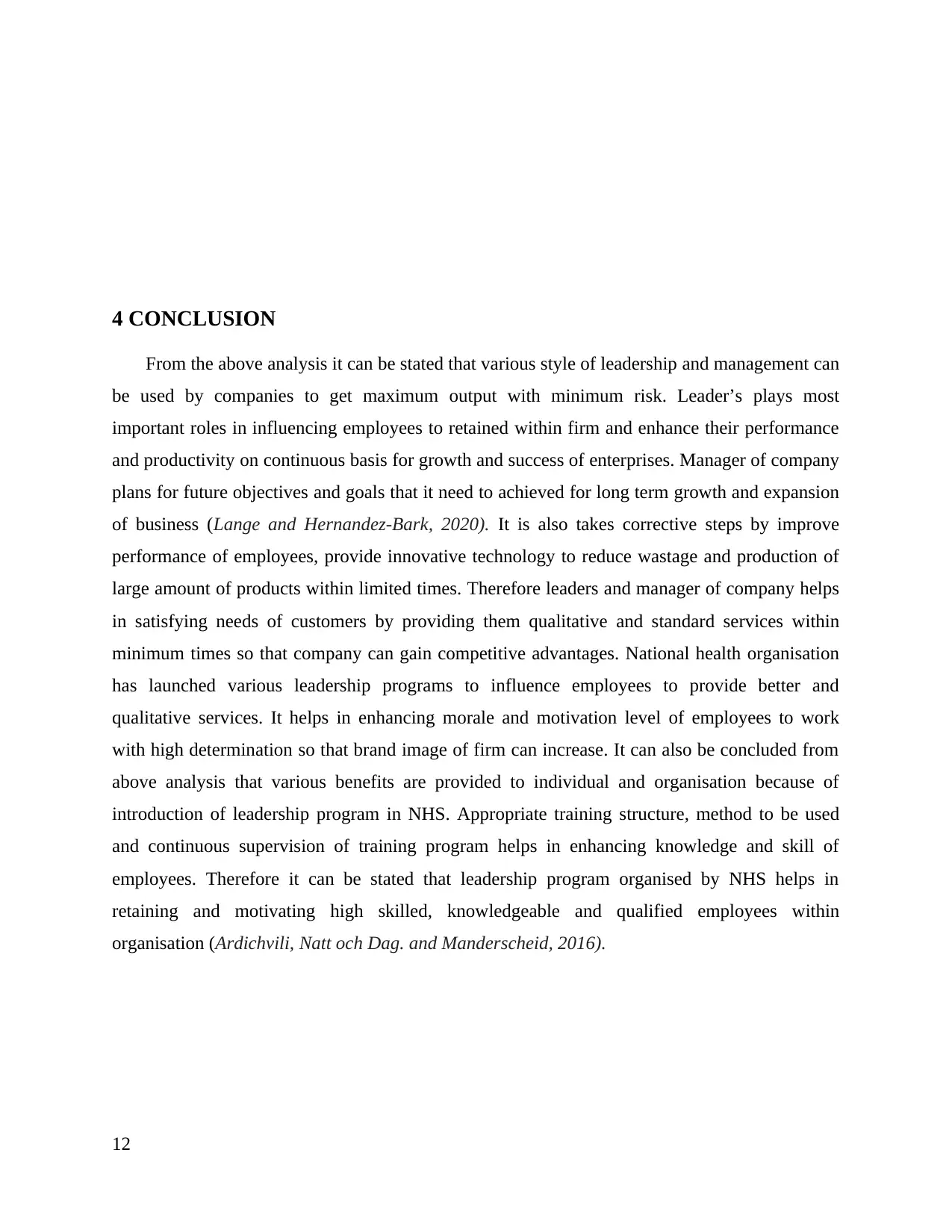
4 CONCLUSION
From the above analysis it can be stated that various style of leadership and management can
be used by companies to get maximum output with minimum risk. Leader’s plays most
important roles in influencing employees to retained within firm and enhance their performance
and productivity on continuous basis for growth and success of enterprises. Manager of company
plans for future objectives and goals that it need to achieved for long term growth and expansion
of business (Lange and Hernandez-Bark, 2020). It is also takes corrective steps by improve
performance of employees, provide innovative technology to reduce wastage and production of
large amount of products within limited times. Therefore leaders and manager of company helps
in satisfying needs of customers by providing them qualitative and standard services within
minimum times so that company can gain competitive advantages. National health organisation
has launched various leadership programs to influence employees to provide better and
qualitative services. It helps in enhancing morale and motivation level of employees to work
with high determination so that brand image of firm can increase. It can also be concluded from
above analysis that various benefits are provided to individual and organisation because of
introduction of leadership program in NHS. Appropriate training structure, method to be used
and continuous supervision of training program helps in enhancing knowledge and skill of
employees. Therefore it can be stated that leadership program organised by NHS helps in
retaining and motivating high skilled, knowledgeable and qualified employees within
organisation (Ardichvili, Natt och Dag. and Manderscheid, 2016).
12
From the above analysis it can be stated that various style of leadership and management can
be used by companies to get maximum output with minimum risk. Leader’s plays most
important roles in influencing employees to retained within firm and enhance their performance
and productivity on continuous basis for growth and success of enterprises. Manager of company
plans for future objectives and goals that it need to achieved for long term growth and expansion
of business (Lange and Hernandez-Bark, 2020). It is also takes corrective steps by improve
performance of employees, provide innovative technology to reduce wastage and production of
large amount of products within limited times. Therefore leaders and manager of company helps
in satisfying needs of customers by providing them qualitative and standard services within
minimum times so that company can gain competitive advantages. National health organisation
has launched various leadership programs to influence employees to provide better and
qualitative services. It helps in enhancing morale and motivation level of employees to work
with high determination so that brand image of firm can increase. It can also be concluded from
above analysis that various benefits are provided to individual and organisation because of
introduction of leadership program in NHS. Appropriate training structure, method to be used
and continuous supervision of training program helps in enhancing knowledge and skill of
employees. Therefore it can be stated that leadership program organised by NHS helps in
retaining and motivating high skilled, knowledgeable and qualified employees within
organisation (Ardichvili, Natt och Dag. and Manderscheid, 2016).
12
⊘ This is a preview!⊘
Do you want full access?
Subscribe today to unlock all pages.

Trusted by 1+ million students worldwide
1 out of 14
Related Documents
Your All-in-One AI-Powered Toolkit for Academic Success.
+13062052269
info@desklib.com
Available 24*7 on WhatsApp / Email
![[object Object]](/_next/static/media/star-bottom.7253800d.svg)
Unlock your academic potential
Copyright © 2020–2025 A2Z Services. All Rights Reserved. Developed and managed by ZUCOL.





